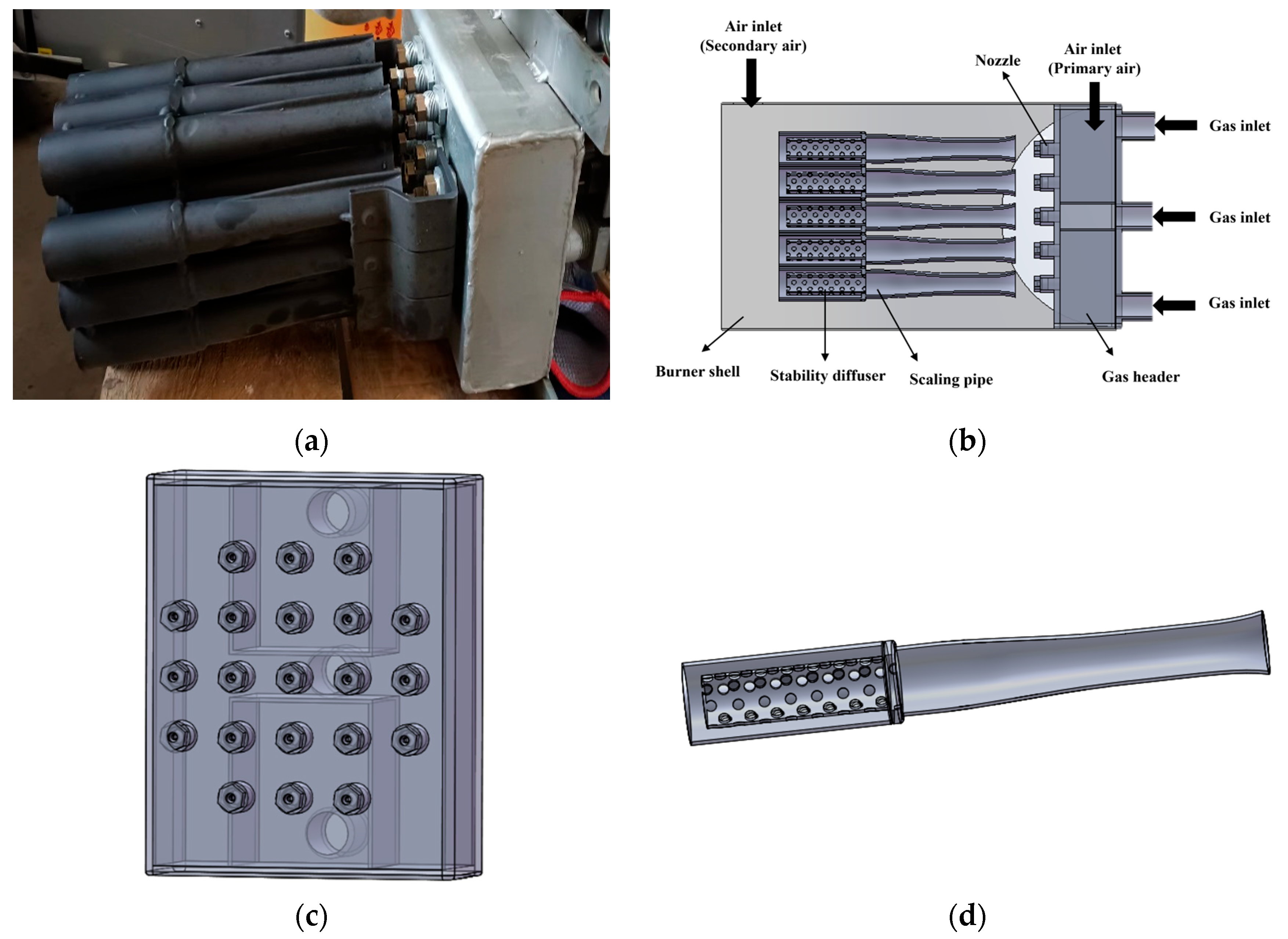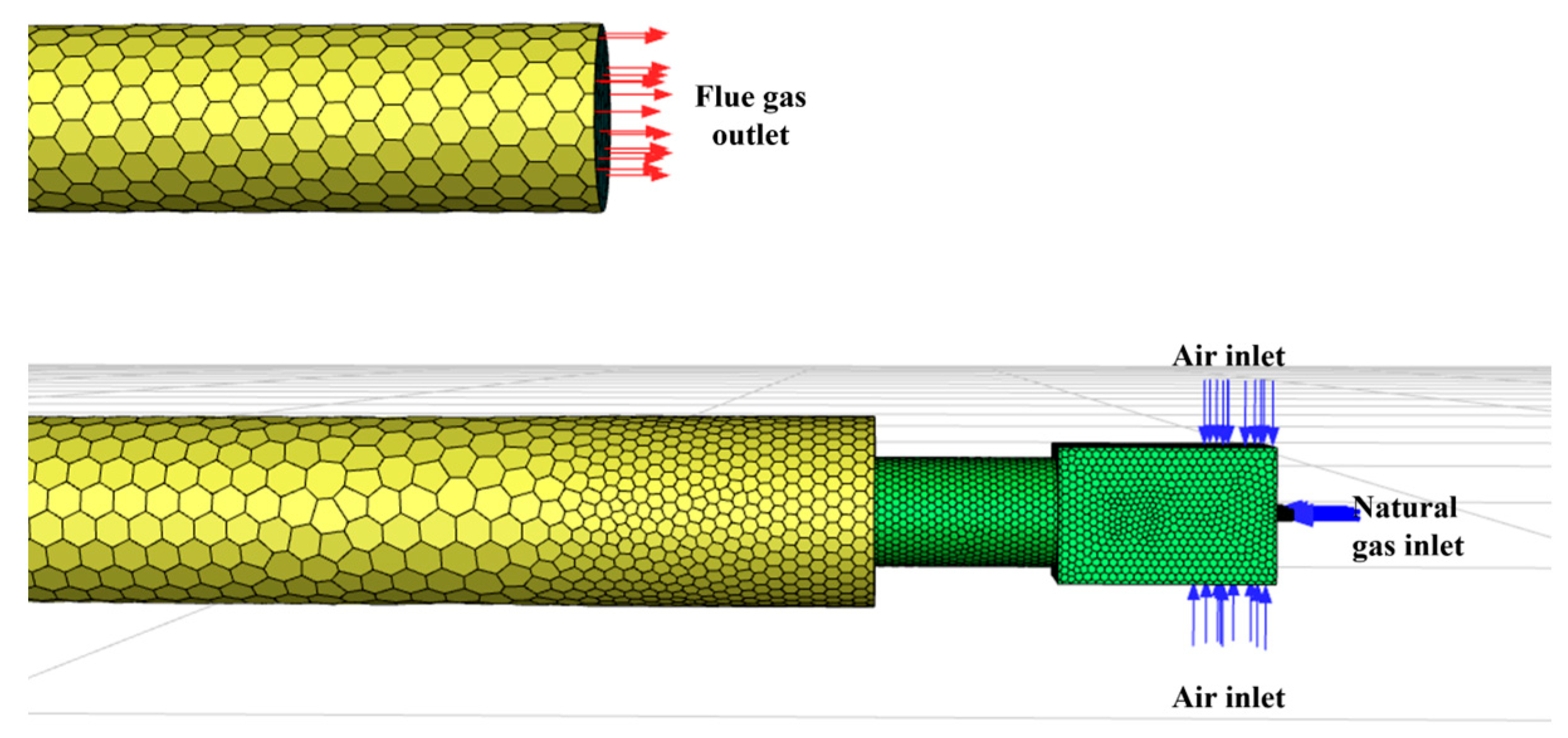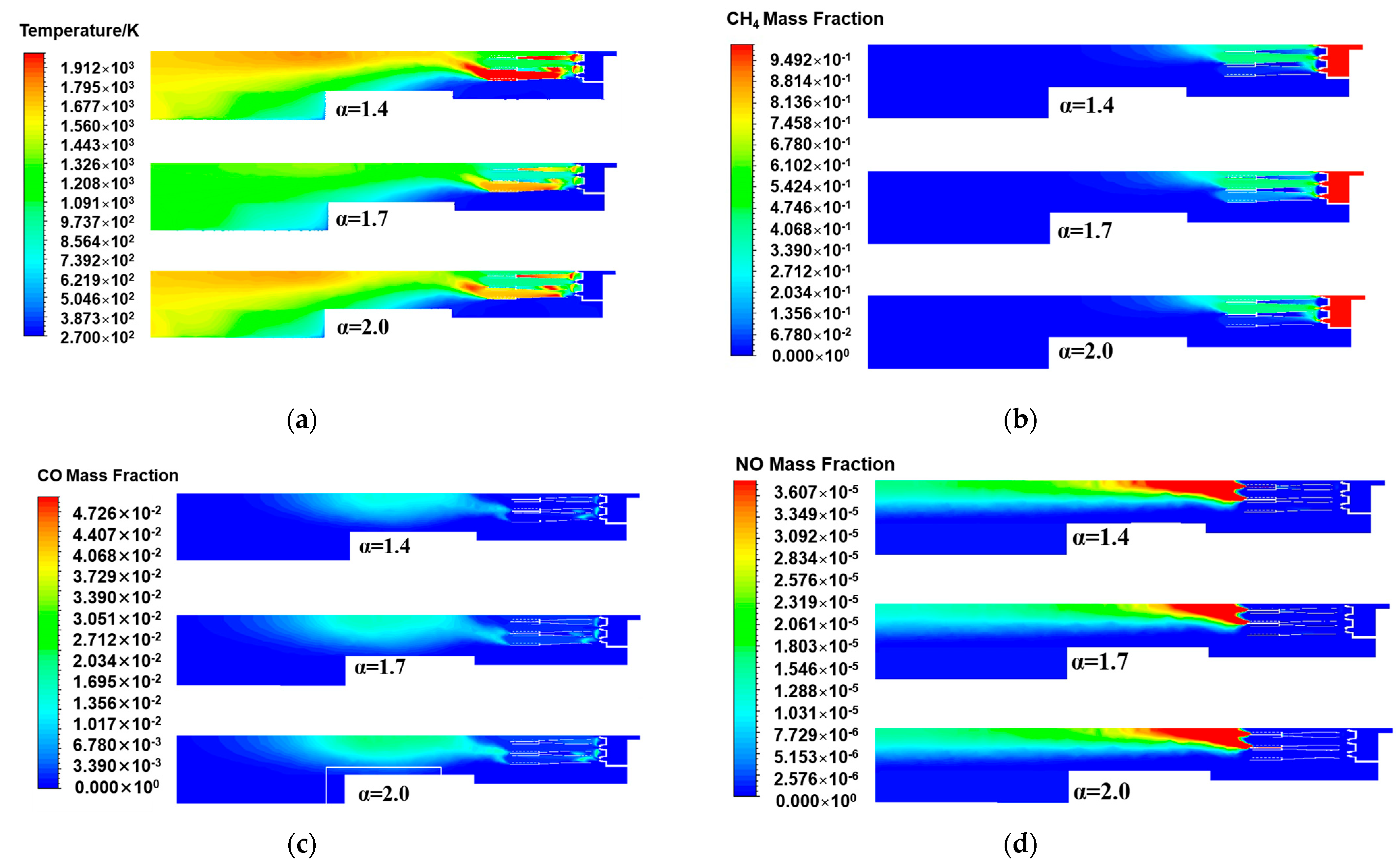Numerical Simulation Study on the Performance of a New Gas Burner for Radiant Heating
Abstract
1. Introduction
2. Materials and Methods
2.1. Physical Model
2.2. Grid Division
2.3. Mathematical Model
2.4. Boundary Conditions
2.4.1. Inlet Boundary Conditions
2.4.2. Outlet Boundary Conditions
2.4.3. Wall Boundary Conditions
2.5. Model Validation
3. Results
3.1. The Influence of the Excess Air Ratio on the Performance of Burners
3.2. The Influence of Air Temperature on the Performance of Burners
3.3. The Influence of Fuel Load on the Performance of Burners
4. Conclusions
- The influence of the excess air ratio on combustion characteristics is evidently significant. As the excess air ratio approaches the theoretical air volume, while combustion efficiency remains relatively high, NOx emissions are observed to increase markedly. Specifically, at the pipeline outlet, NOx emissions have risen by 42.1% compared to those under rated operating conditions. Conversely, increasing the excess air ratio can effectively mitigate nitrogen oxide emissions; however, this adjustment typically results in a decrease in combustion efficiency.
- A reduction in ambient air temperature effectively minimizes NOx emissions; however, it adversely impacts combustion efficiency. Simulation analyses indicate that temperatures within the combustion zone decline markedly under extreme environmental conditions. Consequently, the combustion system must implement adaptive measures to maintain optimal combustion performance in low-temperature air environments.
- The adjustment of the fuel load directly affects the heat output and pollutant emissions of the burner. When the fuel load decreased from 100% to 60%, the NOx emission concentration decreased by 28.7%. A reduction in fuel load decreases nitrogen oxide emissions, but it also triggers a combustion dilution effect, causing the temperature in the combustion chamber to decrease and resulting in a decrease in combustion efficiency.
Supplementary Materials
Author Contributions
Funding
Data Availability Statement
Conflicts of Interest
References
- Xu, J.; Wang, J.; Li, R.; Gu, M. Is Green Finance Fostering High-Quality Energy Development in China? A Spatial Spillover Perspective. Energy Strategy Rev. 2023, 50, 101201. [Google Scholar] [CrossRef]
- Hu, Y.; Man, Y. Energy Consumption and Carbon Emissions Forecasting for Industrial Processes: Status, Challenges and Perspectives. Renew. Sustain. Energy Rev. 2023, 182, 113405. [Google Scholar] [CrossRef]
- Zhu, H.; Cao, S.; Su, Z.; Zhuang, Y. China’s Future Energy Vision: Multi-Scenario Simulation Based on Energy Consumption Structure under Dual Carbon Targets. Energy 2024, 301, 131751. [Google Scholar] [CrossRef]
- Cheng, Z.; Li, L.; Liu, J.; Zhang, H. Research on Energy Directed Technical Change in China’s Industry and Its Optimization of Energy Consumption Pattern. J. Environ. Manag. 2019, 250, 109471. [Google Scholar] [CrossRef] [PubMed]
- Yanto, D.T.P.; Akhmadeev, R.; Hamad, H.S.; Alawadi, A.H.R.; Abdullayev, A.B.; Romero-Parra, R.M.; Fooladi, H. Development and Investigation of a Pollutants Emission Reduction Process from a Coal-Gasification Power Plant Integrated with Fuel Cell and Solar Energy. Int. J. Low-Carbon Technol. 2023, 18, 1120–1133. [Google Scholar] [CrossRef]
- Yan, X.; Ying, Y.; Li, K.; Zhang, Q.; Wang, K. A Review of Mitigation Technologies and Management Strategies for Greenhouse Gas and Air Pollutant Emissions in Livestock Production. J. Environ. Manag. 2024, 352, 120028. [Google Scholar] [CrossRef]
- Mason, J.A.; Oktawiec, J.; Taylor, M.K.; Hudson, M.R.; Rodriguez, J.; Bachman, J.E.; Gonzalez, M.I.; Cervellino, A.; Guagliardi, A.; Brown, C.M. Methane Storage in Flexible Metal–Organic Frameworks with Intrinsic Thermal Management. Nature 2015, 527, 357–361. [Google Scholar] [CrossRef] [PubMed]
- Feng, X.; Jiang, L.; Li, D.; Tian, S.; Zhu, X.; Wang, H.; He, C.; Li, K. Progress and Key Challenges in Catalytic Combustion of Lean Methane. J. Energy Chem. 2022, 75, 173–215. [Google Scholar] [CrossRef]
- Algayyim, S.J.M.; Saleh, K.; Wandel, A.P.; Fattah, I.M.R.; Yusaf, T.; Alrazen, H.A. Influence of Natural Gas and Hydrogen Properties on Internal Combustion Engine Performance, Combustion, and Emissions: A Review. Fuel 2024, 362, 130844. [Google Scholar] [CrossRef]
- Santos, A.A.; Torres, E.A.; Pereira, P.A. Critical Evaluation of the Oxygen-Enhanced Combustion in Gas Burners for Industrial Applications and Heating Systems. J. Braz. Chem. Soc. 2011, 22, 1841–1849. [Google Scholar] [CrossRef]
- Karyeyen, S.; Ilbas, M. Experimental and Numerical Analysis of Turbulent Premixed Combustion of Low Calorific Value Coal Gases in a Generated Premixed Burner. Fuel 2018, 220, 586–598. [Google Scholar] [CrossRef]
- Dudkiewicz, E.; Fidorów-Kaprawy, N.; Szałański, P. Environmental Benefits and Energy Savings from Gas Radiant Heaters’ Flue-Gas Heat Recovery. Sustainability 2022, 14, 8013. [Google Scholar] [CrossRef]
- Kurata, O.; Iki, N.; Inoue, T.; Matsunuma, T.; Tsujimura, T.; Furutani, H.; Kawano, M.; Arai, K.; Okafor, E.C.; Hayakawa, A. Development of a Wide Range-Operable, Rich-Lean Low-NOx Combustor for NH3 Fuel Gas-Turbine Power Generation. Proc. Combust. Inst. 2019, 37, 4587–4595. [Google Scholar] [CrossRef]
- Jia, K.; Liu, C.; Li, S.; Jiang, D. Modeling and Optimization of a Hybrid Renewable Energy System Integrated with Gas Turbine and Energy Storage. Energy Convers. Manag. 2023, 279, 116763. [Google Scholar] [CrossRef]
- Berger, L.; Attili, A.; Pitsch, H. Synergistic Interactions of Thermodiffusive Instabilities and Turbulence in Lean Hydrogen Flames. Combust. Flame 2022, 244, 112254. [Google Scholar] [CrossRef]
- GB 13271-2014; Emission Standard of Air Pollutants for Boiler. China Environmental Science Press: Beijing, China, 2014.
- Wang, J.; Wang, R.; Zhu, Y.; Li, J. Life Cycle Assessment and Environmental Cost Accounting of Coal-Fired Power Generation in China. Energy Policy 2018, 115, 374–384. [Google Scholar] [CrossRef]
- Swaminathan, S.; Spijker, C.; Raonic, Z.; Koller, M.; Kofler, I.; Raupenstrauch, H. Numerical Study of an Industrial Burner to Optimise NOx Emissions and to Evaluate the Feasibility of Hydrogen-Enriched Fuel. Int. J. Hydrogen Energy 2024, 49, 1210–1220. [Google Scholar] [CrossRef]
- Sekar, M.; Alahmadi, T.A.; Nithya, S. Numerical Simulation of Industrial Gas Burners Fueled with Hydrogen-Methane Mixtures for Enhanced Combustion Efficiency and Reduced Greenhouse Gas Emissions. Fuel 2024, 370, 131807. [Google Scholar] [CrossRef]
- Liu, T.; Wang, Y.; Zou, L.; Bai, Y.; Shen, T.; Wei, Y.; Li, F.; Zhao, Q. Numerical Investigation of Stable Combustion at Ultra-Low Load for a 350 MW Wall Tangentially Fired Pulverized-Coal Boiler: Effect of Burner Adjustments and Methane Co-Firing. Appl. Therm. Eng. 2024, 246, 122980. [Google Scholar] [CrossRef]
- Li, Y.; Li, H.; Guo, H.; Li, Y.; Yao, M. A Numerical Investigation on Methane Combustion and Emissions from a Natural Gas-Diesel Dual Fuel Engine Using CFD Model. Appl. Energy 2017, 205, 153–162. [Google Scholar] [CrossRef]
- Deng, J.; Wang, X.; Wei, Z.; Wang, L.; Wang, C.; Chen, Z. A Review of NOx and SOx Emission Reduction Technologies for Marine Diesel Engines and the Potential Evaluation of Liquefied Natural Gas Fuelled Vessels. Sci. Total Environ. 2021, 766, 144319. [Google Scholar] [CrossRef] [PubMed]
- Brändle, G.; Schönfisch, M.; Schulte, S. Estimating Long-Term Global Supply Costs for Low-Carbon Hydrogen. Appl. Energy 2021, 302, 117481. [Google Scholar] [CrossRef]
- Fan, H.; Ma, Y.; Zhang, H.; Zhou, D.; Jia, C.; Yang, H.; Zhang, S.; Luo, Z. Effect of Burner Structural Parameters on Combustion Characteristics and NOx Emission of Natural Gas. Fuel 2024, 372, 132155. [Google Scholar] [CrossRef]
- Lee, H.; Seo, D.M.; Jung, W.-N. Experimental Investigation of NOx Emission Reduction and Efficiency Improvement in a Reheating Furnace Using Multiple Fuel-Flow-Pulsed Burners. Fuel 2025, 394, 135131. [Google Scholar] [CrossRef]
- Huang, H.; Xue, X.; Liu, Y.; Zhao, J.; Tian, M.; Niu, Y. Numerical Studies of a Water-Cooled Premixed Burner for Low NOx Combustion of Natural Gas. J. Energy Inst. 2024, 114, 101647. [Google Scholar] [CrossRef]
- Pandey, B.; Ghimire, R.; Sapkota, N.; Dev, A. Numerical Investigation of Compatibility of Synthetic Natural Gas with Conventional Liquefied Petroleum Gas Burners. J. Phys. Conf. Ser. 2023, 2629, 012031. [Google Scholar] [CrossRef]
- Sarani, I.; Payan, S.; Payan, A.; Nada, S. Enhancement of Energy Storage Capability in RT82 Phase Change Material Using Strips Fins and Metal-Oxide Based Nanoparticles. J. Energy Storage 2020, 32, 102009. [Google Scholar] [CrossRef]
- Aydogdu, M. Analysis of the Effect of Rigid Vegetation Patches on the Hydraulics of an Open Channel Flow with Realizable K-ε and Reynolds Stress Turbulence Models. Flow Meas. Instrum. 2023, 94, 102477. [Google Scholar] [CrossRef]
- Deng, B.; Ge, D.; Lu, L.; Ge, D.; Li, J.; Guo, Y.; Kim, C.N. Use of P-1 Model with the Additional Source Term for Numerical Simulation of Ultraviolet Radiation in a Photoreactor. Korean J. Chem. Eng. 2014, 31, 956–960. [Google Scholar] [CrossRef]
- Winter, F.; Wartha, C.; Löffler, G.; Hofbauer, H. The NO and N2O formation mechanism during devolatilization and char combustion under fluidized-bed conditions. Symp. (Int.) Combust. 1996, 26, 3325–3334. [Google Scholar] [CrossRef]
- Abdullah, M.; Guiberti, T.F.; Alsulami, R.A. Experimental Assessment on the Coupling Effect of Mixing Length and Methane-Ammonia Blends on Flame Stability and Emissions. Energies 2023, 16, 2955. [Google Scholar] [CrossRef]
- Jo, S.; Cho, D. Effects of a Baffle and H2 Injection on Methane Combustion in a Turbulent Fluidized Bed. Fuel 2022, 307, 121883. [Google Scholar] [CrossRef]
- Guo, S.; Lei, Y.; Wang, X.; Qiu, T.; Pang, B.; Shi, L.; An, X. Experimental Research of High-Pressure Methane Pulse Jet and Premixed Ignition Combustion Performance of a Direct Injection Injector. Processes 2021, 9, 1977. [Google Scholar] [CrossRef]
- Tang, X.; Pu, W.; Wang, D.; Qu, S.; Rui, Y.; Zhao, X.; Liu, R. Experimental Study on Non-Isothermal Oxidative Characteristics and Kinetics of Methane in Accelerating Rate Calorimetry Tests. Fuel 2023, 332, 126035. [Google Scholar] [CrossRef]
- Cui, J.; Yu, R.; Wang, H.; Wang, Y.; Tong, J. A Comparative Study of Methanol and Methane Combustion in a Gas Turbine Combustor. Energies 2025, 18, 1765. [Google Scholar] [CrossRef]








| Item | Parameter |
|---|---|
| Rated power (kW) | 300 |
| Rated gas flow (m3/h) | 28.59 |
| Supply pressure (kPa) | 3–5 |
| Fan power (kW) | 3.0 |
| Input current (A) | 5 |
| Exhaust pipe form | Dual-channel parallel |
| Structure | Multi-nozzle subdivided flame integrated machine |
| Grid Type | Number of Grids | Calculation Time of 4000 Steps (h) |
|---|---|---|
| grid 1 | 800,000 | 3.5 |
| grid 2 | 1,000,000 | 4.0 |
| grid 3 | 1,200,000 | 5.0 |
| grid 4 | 1,500,000 | 8.0 |
| Item | Pipeline Outlet Flue Gas Temperature (K) | Pipeline Outlet NOx Emission Concentration (mg/m3) |
|---|---|---|
| Measurement result | 373.0 | 9.8 |
| Simulation result | 364.3 | 9.4 |
| Relative error (%) | 2.4 | 4.1 |
| Excess Air Ratio | Primary Air Flow Rate (kg/s) | Secondary Air Flow Rate (kg/s) |
|---|---|---|
| 1.4 | 0.111 | 0.025 |
| 1.7 | 0.135 | 0.031 |
| 2.0 | 0.159 | 0.036 |
| Excess Air Ratio | Flue Gas Temperature (K) | NOx Emission Concentration (mg/m3) |
|---|---|---|
| 1.4 | 368.1 | 16.2 |
| 1.7 | 364.3 | 9.4 |
| 2.0 | 362.7 | 7.6 |
| Environment Temperature (K) | Flue Gas Temperature (K) | NOx Emission Concentration (mg/m3) |
|---|---|---|
| 243 | 360.7 | 6.2 |
| 268 | 363.0 | 7.6 |
| 300 | 364.3 | 9.4 |
| Fuel Load | Fuel Flow Rate (kg/s) | Primary Air Flow Rate (kg/s) | Secondary Air Flow Rate (kg/s) |
|---|---|---|---|
| 60% | 0.00114 | 0.082 | 0.018 |
| 80% | 0.00152 | 0.106 | 0.024 |
| 100% | 0.0019 | 0.135 | 0.031 |
| Fuel Load | Flue Gas Temperature (K) | NOx Emission Concentration (mg/m3) |
|---|---|---|
| 60% | 359.9 | 6.7 |
| 80% | 361.7 | 7.8 |
| 100% | 364.3 | 9.4 |
Disclaimer/Publisher’s Note: The statements, opinions and data contained in all publications are solely those of the individual author(s) and contributor(s) and not of MDPI and/or the editor(s). MDPI and/or the editor(s) disclaim responsibility for any injury to people or property resulting from any ideas, methods, instructions or products referred to in the content. |
© 2025 by the authors. Licensee MDPI, Basel, Switzerland. This article is an open access article distributed under the terms and conditions of the Creative Commons Attribution (CC BY) license (https://creativecommons.org/licenses/by/4.0/).
Share and Cite
Lv, J.; Li, Z.; Jia, L.; Dou, Y. Numerical Simulation Study on the Performance of a New Gas Burner for Radiant Heating. Fluids 2025, 10, 245. https://doi.org/10.3390/fluids10090245
Lv J, Li Z, Jia L, Dou Y. Numerical Simulation Study on the Performance of a New Gas Burner for Radiant Heating. Fluids. 2025; 10(9):245. https://doi.org/10.3390/fluids10090245
Chicago/Turabian StyleLv, Jinyu, Zongbao Li, Li Jia, and Yinke Dou. 2025. "Numerical Simulation Study on the Performance of a New Gas Burner for Radiant Heating" Fluids 10, no. 9: 245. https://doi.org/10.3390/fluids10090245
APA StyleLv, J., Li, Z., Jia, L., & Dou, Y. (2025). Numerical Simulation Study on the Performance of a New Gas Burner for Radiant Heating. Fluids, 10(9), 245. https://doi.org/10.3390/fluids10090245







